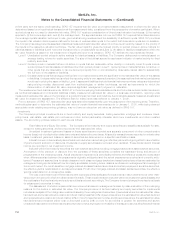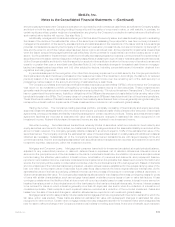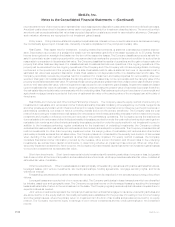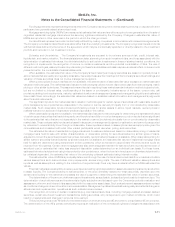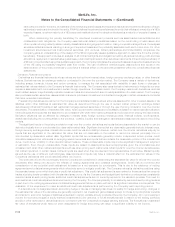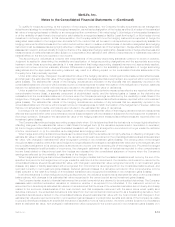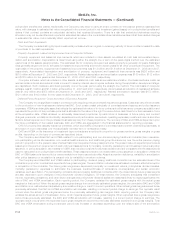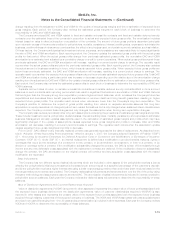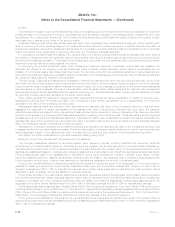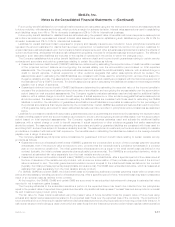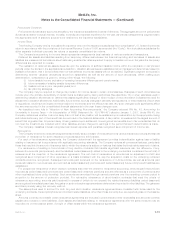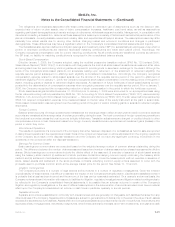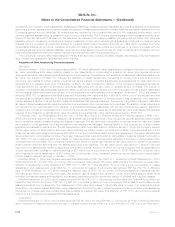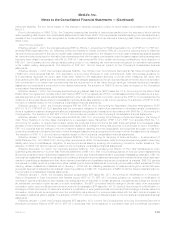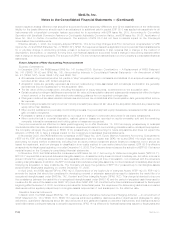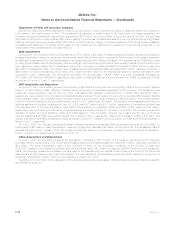MetLife 2008 Annual Report Download - page 141
Download and view the complete annual report
Please find page 141 of the 2008 MetLife annual report below. You can navigate through the pages in the report by either clicking on the pages listed below, or by using the keyword search tool below to find specific information within the annual report.using observable risk free rates. Beginning in 2008, the valuation of these embedded derivatives now includes an adjustment for the
Company’s own credit and risk margins for non-capital market inputs. The Company’s own credit adjustment is determined taking into
consideration publicly available information relating to the Company’s debt as well as its claims paying ability. Risk margins are established
to capture the non-capital market risks of the instrument which represent the additional compensation a market participant would require to
assume the risks related to the uncertainties of such actuarial assumptions as annuitization, premium persistency, partial withdrawal and
surrenders. The establishment of risk margins requires the use of significant management judgment.
These riders may be more costly than expected in volatile or declining equity markets. Market conditions including, but not limited to,
changes in interest rates, equity indices, market volatility and foreign currency exchange rates; changes in the Company’s own credit
standing; and variations in actuarial assumptions regarding policyholder behavior, and risk margins related to non-capital market inputs
may result in significant fluctuations in the estimated fair value of the riders that could materially affect net income.
The Company periodically reviews its estimates of actuarial liabilities for future policy benefits and compares them with its actual
experience. Differences between actual experience and the assumptions used in pricing these policies, guarantees and riders and in the
establishment of the related liabilities result in variances in profit and could result in losses. The effects of changes in such estimated
liabilities are included in the results of operations in the period in which the changes occur.
Policyholder account balances relate to investment-type contracts, universal life-type policies and certain guaranteed minimum benefit
riders. Investment-type contracts principally include traditional individual fixed annuities in the accumulation phase and, non-variable group
annuity contracts. Policyholder account balances for these contracts are equal to (i) policy account values, which consist of an
accumulation of gross premium payments; (ii) credited interest, ranging from 1% to 17% for domestic business and 1% to 15% for
international business, less expenses, mortality charges, and withdrawals; and (iii) fair value adjustments relating to business combina-
tions. Bank deposits related to the Company’s banking operations are also included in policyholder account balances.
Other Policyholder Funds
Other policyholder funds include policy and contract claims, unearned revenue liabilities, premiums received in advance, policyholder
dividends due and unpaid, and policyholder dividends left on deposit.
The liability for policy and contract claims generally relates to incurred but not reported death, disability, long-term care and dental
claims, as well as claims which have been reported but not yet settled. The liability for these claims is based on the Company’s estimated
ultimate cost of settling all claims. The Company derives estimates for the development of incurred but not reported claims principally from
actuarial analyses of historical patterns of claims and claims development for each line of business. The methods used to determine these
estimates are continually reviewed. Adjustments resulting from this continuous review process and differences between estimates and
payments for claims are recognized in policyholder benefits and claims expense in the period in which the estimates are changed or
payments are made.
The unearned revenue liability relates to universal life-type and investment-type products and represents policy charges for services to
be provided in future periods. The charges are deferred as unearned revenue and amortized using the product’s estimated gross profits
and margins, similar to DAC. Such amortization is recorded in universal life and investment-type product policy fees.
The Company accounts for the prepayment of premiums on its individual life, group life and health contracts as premium received in
advance and applies the cash received to premiums when due.
Also included in other policyholder funds are policyholder dividends due and unpaid on participating policies and policyholder dividends
left on deposit. Such liabilities are presented at amounts contractually due to policyholders.
Recognition of Insurance Revenue and Related Benefits
Premiums related to traditional life and annuity policies with life contingencies are recognized as revenues when due from policyholders.
Policyholder benefits and expenses are provided against such revenues to recognize profits over the estimated lives of the policies. When
premiums are due over a significantly shorter period than the period over which benefits are provided, any excess profit is deferred and
recognized into operations in a constant relationship to insurance in-force or, for annuities, the amount of expected future policy benefit
payments.
Premiums related to non-medical health and disability contracts are recognized on a pro rata basis over the applicable contract term.
Deposits related to universal life-type and investment-type products are credited to policyholder account balances. Revenues from
such contracts consist of amounts assessed against policyholder account balances for mortality, policy administration and surrender
charges and are recorded in universal life and investment-type product policy fees in the period in which services are provided. Amounts
that are charged to operations include interest credited and benefit claims incurred in excess of related policyholder account balances.
Premiums related to property and casualty contracts are recognized as revenue on a pro rata basis over the applicable contract term.
Unearned premiums, representing the portion of premium written relating to the unexpired coverage, are included in future policy benefits.
Premiums, policy fees, policyholder benefits and expenses are presented net of reinsurance.
The portion of fees allocated to embedded derivatives described previously is recognized within net investment gains (losses) as part of
the estimated fair value of embedded derivative.
Other Revenues
Other revenues include, in addition to items described elsewhere herein, advisory fees, broker-dealer commissions and fees, and
administrative service fees are also included in other revenues. Such fees and commissions are recognized in the period in which services
are performed. Other revenues also include changes in account value relating to corporate-owned life insurance (“COLI”). Under certain
COLI contracts, if the Company reports certain unlikely adverse results in its consolidated financial statements, withdrawals would not be
immediately available and would be subject to market value adjustment, which could result in a reduction of the account value.
F-18 MetLife, Inc.
MetLife, Inc.
Notes to the Consolidated Financial Statements — (Continued)


